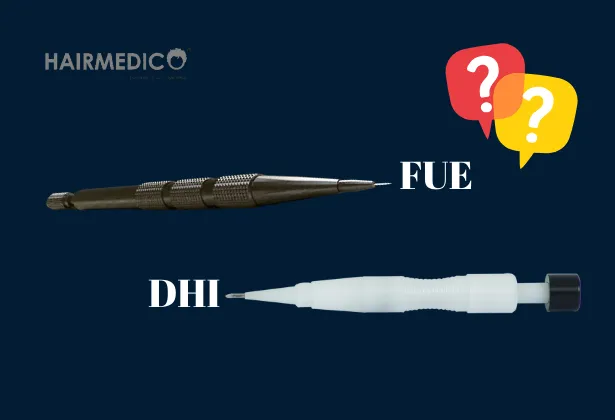
Hair loss can cause significant stress and anxiety, directly impacting self-confidence. Fortunately, hair transplantation is an effective solution for regaining thick and natural-looking hair. Among various existing techniques, the FUE (Follicular Unit Extraction) and DHI (Direct Hair Implantation) methods are the most popular. Although similar in many ways, these methods have notable differences that influence the choice of both patients and surgeons. Let’s explore these differences to understand which method best suits your needs.
The FUE method is currently one of the most commonly used hair transplant techniques. It involves individually extracting hair follicles using a specialized tool, usually called a punch. These follicles are then transplanted into bald or thinning areas of the scalp.
Advantages of FUE:
No visible linear scarring, unlike the older FUT (Follicular Unit Transplantation) method.
Relatively quick recovery and minimal postoperative discomfort.
Ability to use follicles from different parts of the body if necessary.
Disadvantages of FUE:
The extraction process can be lengthy, especially for procedures requiring a large number of grafts.
Increased risk of follicular damage during extraction if performed by an inexperienced surgeon.
The DHI method represents an advancement of the FUE technique, incorporating an innovative system called the Choi Pen or implanter pen. With DHI, follicles are extracted and immediately implanted, eliminating prolonged storage time.
Advantages of DHI:
Increased precision due to the Choi Pen, allowing better control over the angle, depth, and direction of follicle implantation.
Enhanced follicle survival rate by minimizing exposure to the external environment, thus increasing success rates.
Faster procedure with typically easier recovery compared to classic FUE.
Disadvantages of DHI:
Generally higher cost due to advanced technology and specialized equipment required.
Requires significant experience and thorough training to achieve optimal results.
Implantation Process:
FUE: Extracted follicles are temporarily stored before being implanted into previously made incisions.
DHI: Immediate implantation using the Choi Pen without prolonged storage or the need for prior incisions.
Duration of Procedure:
FUE: Generally longer procedure due to multiple steps (extraction, storage, implantation).
DHI: Streamlined process saving considerable time.
Success Rate and Precision:
FUE: High success rate, though highly dependent on surgeon’s experience and storage techniques.
DHI: Often higher follicle survival rate due to reduced out-of-body time and precise implantation.
The choice between FUE and DHI largely depends on your personal expectations, budget, and the nature of your hair loss.
Choose FUE if:
You want a reliable and proven method at a reasonable cost.
You have a generous donor area allowing extensive follicle extraction.
Choose DHI if:
You seek optimal precision and a very natural result, especially for sensitive areas like the hairline.
You prefer rapid recovery with minimal postoperative discomfort.
Since the DHI method typically comes at a higher cost due to advanced technologies, financial considerations might influence your choice. However, it is crucial not to compromise quality for savings. A successful hair transplant requires quality intervention from experienced professionals, regardless of the chosen technique.
Regardless of the selected method, the critical factor remains the surgeon’s experience and skill. Ensure you choose a reputable clinic with a history of successful results and comprehensive support, from initial diagnosis through postoperative follow-up.
In both cases, hair growth progresses gradually, generally starting around the third month after surgery and achieving optimal results within 12 to 18 months. DHI may offer slightly faster recovery due to its minimally invasive nature, but both methods generally provide satisfying long-term outcomes.
Ultimately, the ideal method depends primarily on your personal situation and priorities regarding results, recovery, and budget. Consulting an expert in hair transplantation remains the best approach to accurately determine which technique best matches your profile.